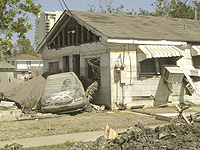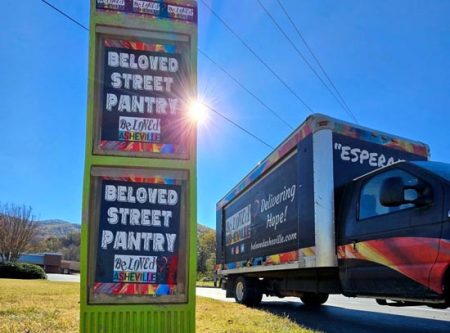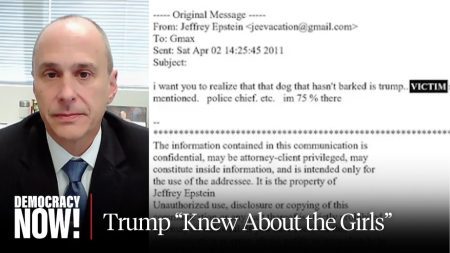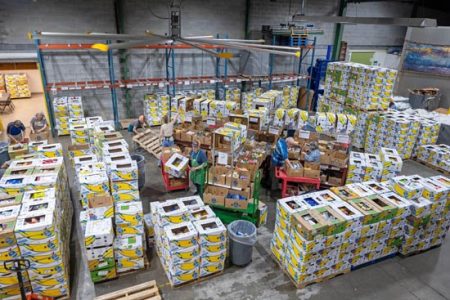Letter from New Orleans:
A Visitor\’s View of Devastation
By Clare Hubbard
Author\’s note: My original intention for this story was to report on the displacement of artists in the city of New Orleans, and try to capture some semblance of the effect Katrina had on the local music/art scene. After staying two blocks from the devastated 9th ward and seeing such bleak imagery, writing about art seemed frivolous. This is my personal account of returning to the city for the first time after the storm.
Driving into New Orleans from Tuscaloosa, Alabama, is like stepping from the richest parts of LA into a war-torn third-world ghetto. The landscape creeps up on you, and suddenly you realize the strip malls are half-standing instead of gleaming, and piles of metal and dead branches have replaced Hummers and BMW motorcycles.
The four of us from two bands (Dig Shovel Dig and Sports), together on tour for 10 days, hadn\’t returned to the Big Easy since Katrina hit. We knew of the devastation from watching superficial television news coverage and from second-hand reports that the club we played last year was underwater and about to be torn down. We had felt shock and even guilt from reading the many stories of Katrina\’s victims in the newspaper. But nothing could have prepared us for the reality of the situation experienced first-hand.
Miles of wind-torn, flood ravaged suburbs lay sprawling close to the highway on either side. We could see into hundreds of living rooms and attics through gaping holes surrounded by glass, wood, metal, remains of cars and mismatched shoes. No cars were actually moving down the trash-filled streets; they looked like road-kill, slowly decomposing in the hot sun.
I expected to see more repair; after watching countless relief efforts on TV and hearing of so many non-profits and aid-workers joining the tremendous effort to clean up the city, I expected to see life and renewal throughout the area. The lines and lines of empty houses and trees crushing cars sparked more than emotion within me; my imagination became my only resource for information. This dark maze of gutted house frames appeared to be the perfect place to commit a severe crime and get away with it. The thought sent shivers down my spine.
As we navigated our way to the club, Big Top 3-ring Circus (an art gallery and show space that is one of the only venues for small bands left in the city), we saw the Super Dome, with its roof slowly being repaired. Piles of shingles sat on its curved roof waiting to be attached, while more rubble piles covered the surrounding sidewalks.
As we entered the city, the sky grew dark, and we became fearful and awed by the complete lack of lights and people. We finally made it to the club and parked beside a huge pile of glass, branches, dresser drawers, and trash bags. It seemed we couldn\’t look anywhere without a giant trash pile obstructing our view. Julie Ebel, who grew up in the city and through much deliberation decided to stay through the “rebuilding,” explained the reason the rubble piles are so huge.
“Trash pickup, for the most part, is random,” she said. “It sometimes takes weeks until the trash is removed from the streets, and that\’s if it\’s in a can. The rubble piles have been here for as long as I can remember. They get bigger and bigger, and nothing happens. We have a complete shortage of people who will work trash pick-up or any low-end job because of the rise in rent and the slow recuperation of basic services for residents. Rent keeps going up, and how could someone getting paid a little above minimum wage, picking up hazardous materials while driving through the most dangerous neighborhoods in America, afford to live in a tiny house for 800+ a month? Most people have left and will never come back,” Ebel said.
It is quite apparent how long these trash piles have endured. The scent of rotting meat and mildew and old food fills the air, along with large clusters of flies that hover above the trash. While this makes for an unpleasant experience, it\’s hard to imagine that the trash alone explains the diminishing numbers of returning residents.
Ebel explained the real reason most people aren\’t coming back. “The crime rates here have been the highest in the country. Now they\’ve skyrocketed because of the hurricane. The crazy thing is, we\’ve only got about 150,000 people living here. The city claims it\’s 225,000 people, or around there, but most of those people live in Jefferson, outside of the city. So that\’s 150,000 people in a city that used to hold about 500,000.”
 |
|
Ninth Ward resident still devastated. |
She continued, “The thing is, the petty thefts and break-ins which used to plague the city have subsided. The majority of the crime is gang warfare. Just two nights ago, about a block and a half away, a bunch of guys were found in their SUV shot in the face.”
I asked why the gangs are suddenly acting out. She explained that after the storm, the gang territory lines, both literally and metaphorically, disintegrated.
“Crews are now rolling in and reclaiming and expanding their territories,” Ebel said. “They are taking care of old business as well. Jobs that needed doing more carefully before the storm they can take care of more easily now. Supposedly, according to the news coverage, what little there is, there have been about 65 murders since the hurricane. I know there\’s been more. You can hear the gunshots through the night.”
We needed to find a place to stay for the night, and a friend of a friend from Asheville named Andy offered to put us up at his place in the 7th ward. We followed him in his old beat-up truck through the dark buildings of downtown. We came to a highway overpass, and driving under it was like entering a makeshift steel graveyard. Hundreds of cars, new and old, were stacked four rows deep and extended into a thick line at least eight blocks long. Each car was smashed in a different way; doors ripped off, windshields hanging on by a thread. Dark outlines of people could barely be seen inside many of the cars. I remembered this area, just a mile from the Super Dome, as a prime location for artist\’s warehouses and clubs. The buildings were still there, now dark and corroding, covered with spray paint and crumbling signs.
Darkness and silence shrouded our car as we moved past blocks and blocks of boarded-up houses and businesses. As we pulled up to the house, a young man approached our car and asked us if we wanted the “good.” We replied in unison, “No, thanks,” and he flashed his gang symbol (index and middle finger raised, kissed, and separated) and crept back into the shadows. This was our only interaction with a local in the 7th ward.
As we got out of the car and made our way up the front steps, a number of shots rang out from down the street. “Someone just unloaded a clip. Let\’s get inside,” Andy said. He rushed us through the door and double-locked it behind us.
To escape the heat of the house, we moved to the back yard, fenced in and partially tree-covered. Oil cans, singed wood, metal siding and dirt piles surrounded us. Andy described the nearby landscape of dark houses. “No one lives there, there, or there, or down there,” he said, pointing to every house in sight. “I think someone lives there, but I haven\’t seen them in a while.”
As the night progressed, we were surrounded by silence. No birds, no laughing down the street, no dogs barking or music from the surrounding neighborhood. A few lights were scattered here and there, but for the most part, darkness and silence. Then the sky lit up with helicopter searchlights combing the alleyways and streets surrounding us. Andy\’s friend explained, “They\’re just shining their lights to remind people they are here. I don\’t think they do much else. What can they do? People here are so quick. You think this is bad,” he added. “Imagine what\’s going on in the suburbs right now.”
I could go further, and describe our fear in great detail, or how one of us was too scared to walk ten feet from the front door to the truck to get a sleeping bag. As a result, he slept on the hard wood floor.
Before this visit, I had been to other countries where the police struggled to keep the peace and control whatever mayhem existed. But to experience such violent sounds and images on such a large scale in the United States is life-changing. Those of us who rely on the news for updates on the Katrina aftermath really have no idea what is going on, or that the police lose more and more control each day.
According to local performance artist Vanessa Skantze, “They called the National Guard in to patrol the suburbs so that the cops would have less on their plate. But all they can do is wait for the next gunshot, and follow the trails left behind.” She added, “This is probably one of the only cities in America where the police don\’t have control. It\’s a real eye-opener for anyone that actually comes here, expecting to see rebirth and construction.”
I ask why she chooses to live here, and how she copes with the violence. “ I live here because when I leave, the city calls to me. This place is unlike any other place. None of us know what\’s going to happen, but we are here to make sure it doesn\’t lose its personality and become like every other homogenized city in America. There is so much energy in the air right now, even though it\’s silent energy, and it\’s keeping us all alive. We\’re waiting to see what happens. Either way, it looks like it\’s going to be extreme.”
On our way out of New Orleans, I think of our band\’s recent drives through Georgia, Tennessee, Alabama, Kentucky, Wisconsin, Indiana, South Carolina, Minnesota, and elsewhere. One thought goes through my head, and it continues as I write this: “This could happen anywhere.”
Article written by Clare Hubbard after her June 26, 2006 trip to New Orleans.








